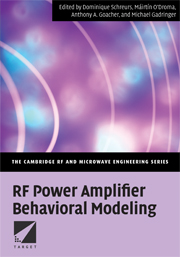Book contents
- Frontmatter
- Contents
- Notation
- Abbreviations
- Preface
- 1 Overview of power amplifier modelling
- 2 Properties of behavioural models
- 3 Memoryless nonlinear models
- 4 Nonlinear models with linear memory
- 5 Nonlinear models with nonlinear memory
- 6 Validation and comparison of PA models
- 7 Aspects of system simulation
- Appendix A Recent wireless standards
- Appendix B Authors and contributors
- Index
7 - Aspects of system simulation
Published online by Cambridge University Press: 06 January 2010
- Frontmatter
- Contents
- Notation
- Abbreviations
- Preface
- 1 Overview of power amplifier modelling
- 2 Properties of behavioural models
- 3 Memoryless nonlinear models
- 4 Nonlinear models with linear memory
- 5 Nonlinear models with nonlinear memory
- 6 Validation and comparison of PA models
- 7 Aspects of system simulation
- Appendix A Recent wireless standards
- Appendix B Authors and contributors
- Index
Summary
Introduction
Simulation is widely used in the design and analysis of complex communications systems. The aim is to describe the operating characteristics and performance of all or part of a communication link, whether simple or complex, and to mimic through mathematical models all the analogue and digital signal processing activities, whether at baseband, IF or RF frequencies. System-level simulations can be based on time-domain or frequency-domain techniques or on a combination of both. Time-domain models are the norm in system-level digital signal processing (DSP) simulations while the frequency-domain approach is a popular choice for RF circuitlevel simulation, even though time-domain simulation is also much used, especially in connection with equivalent baseband envelope techniques such as the circuit envelope. When nonlinearities exist in the system it is difficult to simulate other than in the time domain, although harmonic-balance, mixed frequency-domain and time-domain approaches on statistical techniques may be used.
Well-known commercial dedicated simulation and electronic design automation software systems, such as Applied Wave Research's Microwave Office (AWR-MO) and Virtual System Simulator (AWR-VSS) and Agilent's Advanced Design System (ADS), provide both circuit-level and system-level simulation capability, with the possibility of including nonlinear microwave PA models also. Other robust commercial simulation tools for circuit-level mixed (analogue and digital signal) communication systems are the ‘Virtuoso’ platform from Cadence and the HSPICE simulator from Synopsis. There is ongoing widespread research in this area especially to increase the capacity to handle more complex systems, to develop library modules for new technologies and to improve simulation efficiency.
- Type
- Chapter
- Information
- RF Power Amplifier Behavioral Modeling , pp. 233 - 252Publisher: Cambridge University PressPrint publication year: 2008

